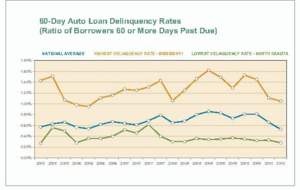CHICAGO, IL--(Marketwire - August 30, 2010) - The national 60-day auto delinquency rate (the ratio of auto loan borrowers 60 or more days past due) fell 19.7 percent between the first and second quarters of 2010 to 0.53 percent, according to a TransUnion quarterly analysis of trends in the auto industry. The year-over-year delinquency rate at the national level fell by 27.4 percent in the second quarter.
Quarterly Auto Statistics
- Auto loan delinquency was highest in Mississippi and Louisiana at 1.05 percent and 0.97 percent, respectively. The lowest auto loan delinquency rates were found in North Dakota (0.28 percent), Michigan (0.29 percent) and Pennsylvania (0.32 percent).
- The largest improvements in delinquency from the previous quarter were found in Vermont (41.4 percent decrease from 0.58 percent) and Connecticut (36.4 percent decrease from 0.55 percent).
- Auto loan delinquency rates rose for only three states since the first quarter of 2010 -- Rhode Island came in at 0.74 percent (a 29.8 percent increase), Utah at 0.71 percent (a 16.4 percent increase), and Montana at 0.38 percent (2.7 percent increase).
- Average auto debt nationally rose quarter over quarter from $12,501 to $12,643. Year-over-year, auto debt increased by 1.13 percent in the second quarter.
- The District of Columbia held the largest average auto debt burden at $15,625, followed by Wyoming at $14,534. The lowest average auto debt was in Nebraska at $11,118.
- The regions with the steepest quarterly increases in average auto debt as a percentage were North Dakota (+5.1 percent), the District of Columbia (+4.8 percent) and South Dakota (+3.2 percent). New Jersey experienced the sharpest drop in average auto debt (-1.3 percent), followed by Nevada (-0.79 percent).
- On a year-over-year basis, national bank auto originations increased by the largest margin since the recession began in late 2007 (18.7 percent). District of Columbia led all other areas showing an increase in auto originations by 55.4 percent since the second quarter 2009. On a regional basis, only one state (Hawaii) showed a drop in year-over-year originations.
Analysis and Supporting Quotes
"The national trend we are seeing continues to point to a clear improvement in payment behavior. Although part of the reason for the turnaround in delinquency rates is the influx of new, lower risk loans as we have noted before, consumers do not see a quick fix to the short term economic and employment situation and are focusing their attention instead on savings and lower consumption of discretionary goods. This movement toward fiscal responsibility is reflected in year-over-year results as auto delinquency rates now have dropped 27.4 percent since second quarter 2009 - the largest decline since the summer of 2001. On a state-level basis, 46 states experienced a drop in their quarter-to-quarter delinquency rates, while only 3 states showed an increase on a year-over-year basis."
Peter Turek, automotive vice president in TransUnion's financial services group
Auto Delinquency Forecast
"Since the beginning of the recession, TransUnion's national and state forecasting models have tracked how the national 60-day auto delinquency rates are impacted by economic factors such as per capita disposable income, interest rates for new car loans, unemployment rates, and new vehicle registrations. These econometric models are continuing to hold up well, as they predicted a significant a drop in this quarter's 60 day auto delinquency rate. Based on our current economic assumptions, TransUnion believes that the 60-day auto delinquency rate will continue to show seasonal patterns, but gradually drift upward, reaching a rate of around 0.6 percent by the fourth quarter of this year"
Peter Turek, automotive vice president in TransUnion's financial services group
2Q10 Recap of Consumer Credit Habits - Mortgage and Credit Cards
- TransUnion's quarterly analysis of trends in the mortgage industry found that national mortgage loan delinquency rate decreased again in the second quarter of 2010. This statistic reflects a decrease of 1.48 percent from the previous quarter's 6.77 percent national average. Year over year, mortgage borrower delinquency is still up approximately 14.8 percent (from 5.81 percent in the second quarter 2009).
- Mortgage borrower delinquency rates in the second quarter of 2010 continued to be highest in Nevada (15.86 percent) and Florida (15.02 percent), while the lowest mortgage delinquency rates continued to be found in North Dakota (1.61 percent), South Dakota (2.23 percent) and Nebraska (2.61 percent).
- Twelve states showed increases in delinquency from the previous quarter with Rhode Island (+4.63 percent), New Mexico (+4.45 percent) and Washington (+3.39 percent) leading the pack.
- TransUnion believes that the 60-day mortgage delinquency rate will likely continue to drift downward in 2010, possibly nearing 6.4 percent nationally by the end of the year.
- TransUnion's quarterly analysis of trends in the credit card industry revealed that the national credit card delinquency rate decreased to 0.92 percent in the second quarter, down 17.1 percent over the previous quarter. Year over year, credit card delinquencies fell by 21.3 percent.
- Incidence of credit card delinquency was highest in Nevada (1.50 percent), followed by Florida (1.24 percent) and Arizona (1.11 percent). The lowest credit card delinquency rates were found in North Dakota (0.54 percent), South Dakota (0.55 percent) and the District of Columbia (0.61 percent).
- Average credit card borrower debt drifted downward for the fifth consecutive quarter nationally by 4.1 percent to $4,951 from the previous quarter's $5,165, and down 13.4 percent compared to the second quarter of 2009 ($5,719). This represented the first period credit card debt was below $5,000 since the first quarter of 2002.
- Based on current economic assumptions, TransUnion believes that the 90-day credit card delinquency rate, apart from seasonal ups and downs, will continue to decrease in 2010, staying below 1.0 percent throughout the remainder of this year.
Supporting Resources/Links
TransUnion Trend Data
TransUnion 2Q Mortgage Statistics
TransUnion 2Q Credit Card Statistics
TransUnion Payment Hierarchy Study
TransUnion Value of Loyalty/Delinquency Study
TransUnion on Twitter
TransUnion's Trend Data database
The report is part of an ongoing series of quarterly consumer lending sector analyses focusing on credit card, auto loan and mortgage data available on TransUnion's Web site. Information for this analysis is culled from TransUnion's Trend Data, a one-of-a-kind database consisting of 27 million anonymous, credit-active consumer records that provide a real-life perspective on how consumers are managing their credit health.
Randomly sampled every quarter from TransUnion's national consumer credit database, each record contains more than 200 credit variables that illustrate consumer credit usage and performance. Since 1992, TransUnion has been aggregating this information at the county, Metropolitan Statistical Area (MSA), state and national levels.
About TransUnion
As a global leader in credit and information management, TransUnion creates advantages for millions of people around the world by gathering, analyzing and delivering information. For businesses, TransUnion helps improve efficiency, manage risk, reduce costs and increase revenue by delivering comprehensive data and advanced analytics and decisioning. For consumers, TransUnion provides the tools, resources and education to help manage their credit health and achieve their financial goals. Through these and other efforts, TransUnion is working to build stronger economies worldwide. Founded in 1968 and headquartered in Chicago, TransUnion employs associates in more than 25 countries on five continents. www.transunion.com/business
Contact Information:
Contact
Dave Blumberg
TransUnion
E-mail
Telephone 312 972 6646

